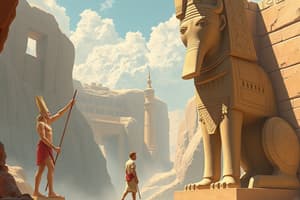Podcast
Questions and Answers
What does formalism primarily focus on in art criticism?
What does formalism primarily focus on in art criticism?
- The meaning behind the artwork
- The historical context of the artwork
- The form and appearance of the artwork (correct)
- The emotional impact of the artwork
Style can be used to identify an artist and provide context about their work.
Style can be used to identify an artist and provide context about their work.
True (A)
Who believed that styles change in response to pre-existing beliefs?
Who believed that styles change in response to pre-existing beliefs?
James Ackerman
A _____ is an expert who evaluates art and can make judgments about its value and authenticity.
A _____ is an expert who evaluates art and can make judgments about its value and authenticity.
Match the following terms with their definitions:
Match the following terms with their definitions:
What concept did Winckelmann believe architecture should prioritize?
What concept did Winckelmann believe architecture should prioritize?
Winckelmann believed that sculpture was primarily concerned with abstract forms rather than the human figure.
Winckelmann believed that sculpture was primarily concerned with abstract forms rather than the human figure.
What is contained within a monograph?
What is contained within a monograph?
What does Hellenism capture in relation to ancient Greek culture?
What does Hellenism capture in relation to ancient Greek culture?
Connoisseurs often focus on several art periods and various artists.
Connoisseurs often focus on several art periods and various artists.
What is the Morellian Method primarily focused on?
What is the Morellian Method primarily focused on?
What is the primary goal of a monograph?
What is the primary goal of a monograph?
Winckelmann described the Greek Ideal as a balance of embodying the pinnacle of moral and physical __________.
Winckelmann described the Greek Ideal as a balance of embodying the pinnacle of moral and physical __________.
Roger Fry believed that modern art should directly parallel existing thoughts.
Roger Fry believed that modern art should directly parallel existing thoughts.
Which of the following methods did not play a significant role in art history according to the content?
Which of the following methods did not play a significant role in art history according to the content?
What does the term 'Kunstwollen' mean?
What does the term 'Kunstwollen' mean?
Match the following concepts with their descriptions:
Match the following concepts with their descriptions:
Wölfflin believed that not everything is possible for every artist at all times.
Wölfflin believed that not everything is possible for every artist at all times.
Giovanni Morelli's method identifies artists through minute details like the way they paint _______.
Giovanni Morelli's method identifies artists through minute details like the way they paint _______.
Which concept is associated with Alois Riegl?
Which concept is associated with Alois Riegl?
What qualities did Winckelmann emphasize in Hellenism?
What qualities did Winckelmann emphasize in Hellenism?
Roger Fry believed that art needs to stay connected to real-life morals.
Roger Fry believed that art needs to stay connected to real-life morals.
Which school of thought did Alois Riegl belong to?
Which school of thought did Alois Riegl belong to?
Match the following artists with their beliefs or concepts:
Match the following artists with their beliefs or concepts:
Who emphasized the significance of cultural and historical contexts in art?
Who emphasized the significance of cultural and historical contexts in art?
Heinrich Wölfflin is known for his emphasis on the emotional expression in artworks.
Heinrich Wölfflin is known for his emphasis on the emotional expression in artworks.
What are the five opposites identified by Heinrich Wölfflin?
What are the five opposites identified by Heinrich Wölfflin?
Johann Joachim Winckelmann is closely associated with the _________ movement.
Johann Joachim Winckelmann is closely associated with the _________ movement.
Match the following art historians with their contributions:
Match the following art historians with their contributions:
Which of the following are characteristics of the Linear vs. Painterly opposition?
Which of the following are characteristics of the Linear vs. Painterly opposition?
Winckelmann's work influenced only modern painting and sculpture.
Winckelmann's work influenced only modern painting and sculpture.
What did Winckelmann emphasize in his book 'The History on Ancient Art among the Greeks'?
What did Winckelmann emphasize in his book 'The History on Ancient Art among the Greeks'?
Flashcards
Giovanni Morelli
Giovanni Morelli
An art historian who believed that art historians focused too much on beliefs rather than on the artists' actual techniques.
Morellian Method
Morellian Method
A method used to attribute artworks to artists based on specific details in their paintings, such as the way they paint ears, fingers, or hands.
Roger Fry
Roger Fry
An English art critic who championed Post-Impressionism and believed that art exists independently of our everyday experiences.
Art's Special Domain
Art's Special Domain
Signup and view all the flashcards
Aesthetic Detachment
Aesthetic Detachment
Signup and view all the flashcards
Alois Riegl
Alois Riegl
Signup and view all the flashcards
Kunstwollen
Kunstwollen
Signup and view all the flashcards
Function of Forms and Motifs
Function of Forms and Motifs
Signup and view all the flashcards
Formalism
Formalism
Signup and view all the flashcards
Style
Style
Signup and view all the flashcards
Connoisseur
Connoisseur
Signup and view all the flashcards
Monograph
Monograph
Signup and view all the flashcards
Mimesis
Mimesis
Signup and view all the flashcards
Ackerman's Theory of Style Change
Ackerman's Theory of Style Change
Signup and view all the flashcards
Art Historical Methods
Art Historical Methods
Signup and view all the flashcards
Style Change
Style Change
Signup and view all the flashcards
Imitation of the Greeks
Imitation of the Greeks
Signup and view all the flashcards
Hellenism
Hellenism
Signup and view all the flashcards
The Greek Ideal
The Greek Ideal
Signup and view all the flashcards
Connoisseurship
Connoisseurship
Signup and view all the flashcards
What controls the history of art?
What controls the history of art?
Signup and view all the flashcards
What is 'Geist'?
What is 'Geist'?
Signup and view all the flashcards
What are Wölfflin's 'Five Opposites'?
What are Wölfflin's 'Five Opposites'?
Signup and view all the flashcards
What is 'Linear' in art?
What is 'Linear' in art?
Signup and view all the flashcards
What is 'Recession' in art?
What is 'Recession' in art?
Signup and view all the flashcards
What is 'Closed Form' in art?
What is 'Closed Form' in art?
Signup and view all the flashcards
What is 'Open Form' in art?
What is 'Open Form' in art?
Signup and view all the flashcards
What is the Neoclassical Movement?
What is the Neoclassical Movement?
Signup and view all the flashcards
Study Notes
Formalism in Art History
- Formalism is an art criticism method focusing on artwork's form (colors, shapes, composition) rather than meaning.
- Formalism gained popularity in the mid-19th century, shifting focus from imitation (mimesis) to style.
Style in Art
- Style describes the distinctive characteristics of artworks or groups of artworks.
- Style helps contextualize works and identify artists.
- Examples: Impressionist style (bright colors, swirling lines) or Medieval style (religious imagery).
- Style reflects artist training, influences, and personality, along with the cultural context of creation.
- Styles change as solutions or responses to pre-existing beliefs, driven by human restlessness and challenges to conventions.
Connoisseurship
- Connoisseurs are experts in art taste who need direct knowledge of art to judge the artist or work.
- They focus on specific periods, nations, or artists' lives.
- Connoisseurs authenticate, appraise value, and write about art.
Monographs
- Monographs are definitive studies of an artist's complete works (oeuvre).
- These include artist biographies, catalogues raisonnés (critical catalogues of works), and bibliographic references.
- The goal is to analyze how the artist's style reflects their training and the era they worked in.
- Monographs require extensive research and documentation.
Giovanni Morelli
- Morelli was an Italian 19th-century art critic who prioritized experience over belief.
- Morelli developed the "Morellian Method" for attributing artworks based on minute details (like hand, ear, finger painting).
- These details, considered like handwriting, could identify artists even without signatures or alterations.
Roger Fry
- Fry was an English art critic who championed Post-Impressionism.
- Fry believed art had a unique, separate domain detached from everyday experience.
- He believed that modern art was independent of real-life morals and ethics, free of preconceptions.
Alois Riegl
- Riegl was an Austrian art historian crucial for formalizing art history as an academic discipline.
- He focused on the historical development of artistic style.
- He researched textiles and believed "Kunstwollen" (will to art) is the guiding principle of art—a suprapersonal force directing art history.
- Riegl emphasized context (cultural, historical, philosophical) as important in artistic creation.
Heinrich Wölfflin
- Wölfflin was a Swiss art historian who created a methodology for viewing art through formalist criteria.
- He cataloged formalistic opposites (like linear/painterly, plane/recession) to compare artistic styles (e.g. Renaissance/Baroque).
Johann Joachim Winckelmann
- Winckelmann was a German archaeologist and art historian who was instrumental in reviving interest in Classical Art (particularly Ancient Greece).
- His work focused on the Neoclassical movement.
- He stressed that the Greek ideal in art focused on balance, harmony, and clarity. His work greatly influenced Western art, literature, and philosophy.
Hellenism
- Hellenism focuses on the cultural and intellectual spirit of ancient Greece, particularly the concepts of beauty, balance, and harmony.
- Winckelmann emphasized these aspects as crucial in assessing Greek art.
Studying That Suits You
Use AI to generate personalized quizzes and flashcards to suit your learning preferences.




